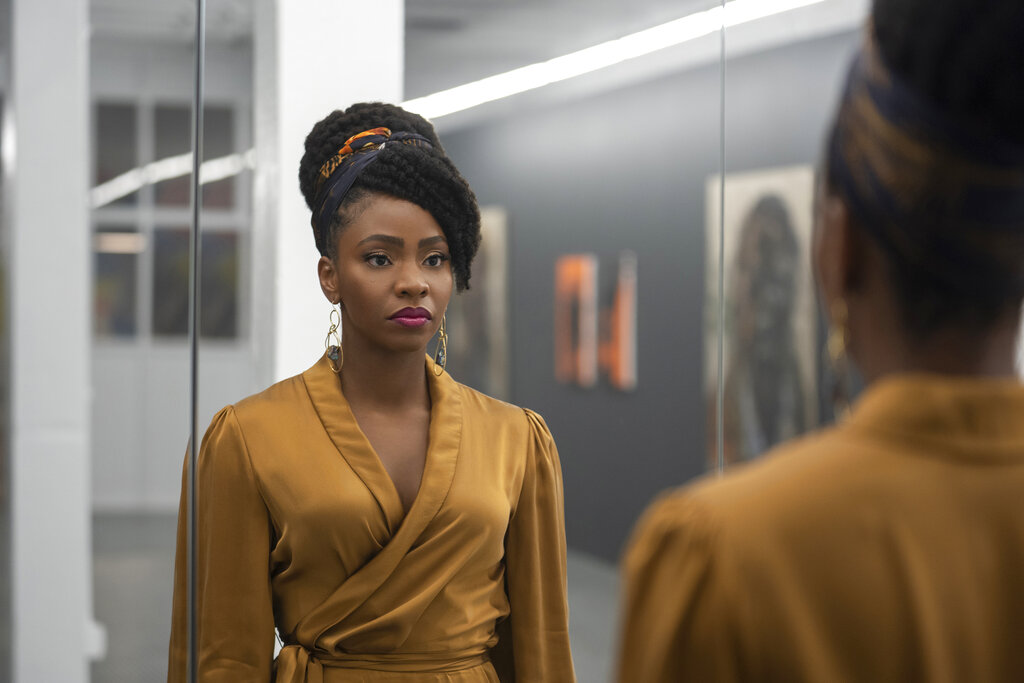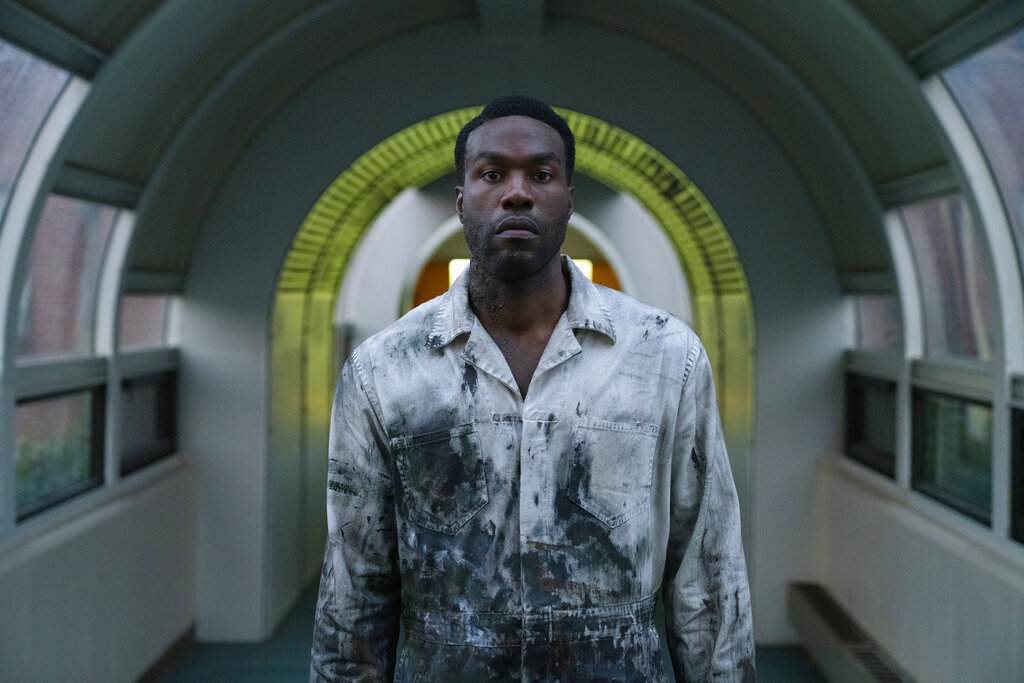Rebecca’s Take
In the last few years, I’ve become a big horror movie fan, which has meant playing catchup with films that I was too scared to watch until recently. Add 1992’s “Candyman” to that list.
The horror classic starring Tony Todd’s vengeful boogeyman with a hook for a hand who kills people after his name is said five times surprised me. It wasn’t your typical slasher flick. Instead, the thoughtful and unsettling film effectively blended urban legend frights with social commentary on systemic racism.
Nearly 30 years later amid a national reckoning of racial injustice, the time is ripe for a new take on the horror icon. Enter “Candyman,” a direct sequel and semi-reboot of the original that disregards later entries in the series. Director and co-screenwriter Nia DaCosta helms a chilling and visually arresting follow-up that dives headfirst into the generational trauma of racial violence. But where “Candyman” excels in crafting stunning imagery, memorable scares and socially conscious themes, the new film falls behind the original in storytelling and characterization.
The sequel follows Anthony McCoy (Yahya Abdul-Mateen II), an artist living in Chicago whose creativity has stalled. When Anthony is introduced to the legend of Candyman, he finds inspiration for his upcoming show at an art gallery where his girlfriend, Brianna Cartwright (Teyonah Parris), works. However, his artwork unleashes an unintended consequence – resurrecting the Candyman, whose murderous spree racks up a high body count. As Anthony gives in to his growing obsession with the Candyman, he discovers he’s more connected to the legendary phantom than he realized.
Full of eye-popping imagery, “Candyman” looks gorgeous, showcasing DaCosta’s talent for visual artistry. The film is stylistically more interesting than its predecessor. It uses shadow puppets when recounting the urban legends, an effective tool that highlights Anthony’s profession as a visual artist. Under DaCosta’s creative eye, Candyman’s kills have more flair, adding to the terror. The techniques make the new film scarier than the original.
DaCosta knows when to ramp up the tension before the ghoulish killer turns up, backed by a heart-pumping score by Robert Aiki Aubrey Lowe. The director shows moviegoers just enough of the slayings to whet their appetite for gore before cutting away, leaving more of the horror to the viewer’s imagination. The film elegantly uses Candyman’s ability to materialize in mirrors to unnerving effect, revealing its villain in an art exhibit, a dropped compact and the walls of an elevator as he commits his dastardly deeds while appearing invisible to onlookers. Todd’s return is welcome as the titular Candyman, though his screen time is little.
“Candyman” expands upon its fabled phantom’s origins, elevating his relevance for our turbulent times. The sequel was produced and co-written by Jordan Peele, who has taken social horror to new heights with films like 2017’s masterful “Get Out.” The original identified Candyman as the son of a slave who became a sought-after artist, but who was tortured and killed by an angry white mob after he fell in love with a white woman and got her pregnant. The new film alters Candyman’s backstory to explain that he is the amalgamation of various black men who have died unjustly from racially inflamed violence. It’s a vicious cycle that continues to this day, with George Floyd’s killing by a white police officer stirring protests last summer across the country – the same year “Candyman” was supposed to debut in theaters before being delayed by the coronavirus pandemic. “Say His Name,” the film’s tagline and the theme of Anthony’s exhibit, calls on moviegoers to remember the victims of racial violence and strikes at the heart of the Black Lives Matter movement.
The change in backstory provides more sense for the murderous boogeyman’s motivations for killing. During the original film, I had a hard time understanding why Candyman killed the Black inhabitants of the crime-infested Cabrini-Green housing projects, the victims of the same institutional racism that robbed Candyman of his life. By allowing Candyman to personify the Black rage that has built up after generations of killings, the horror icon has a new purpose: to avenge centuries of racial injustice. This transforms Candyman from a supernatural slasher seeking retribution to one fighting for justice.
While the original film’s social commentary was subtle, the new “Candyman” is anything but. This affects the movie’s storytelling as some scenes are weighed down by exposition. The original film’s storytelling flows better from scene to scene, with smoother transitions and an almost literary quality. In the sequel, the messaging can seem heavy-handed as the characters talk often about gentrification. It’s a message the movie needs to make clear for its viewers, but the film can feel like it’s hitting you over the head.
With its emphasis on artistry, “Candyman” sacrifices character development and a bit of mystery. The first film follows graduate student Helen Lyle (Virginia Madsen) as she seeks to uncover the legend of the Candyman for her thesis. As the film progresses, Helen evolves from a curious outsider at the Cabrini-Green projects to an involved insider who may or may not have turned into a killer herself. In the sequel, there’s no mystery as the film tells you what’s happening as it goes along.
As Anthony, Abdul-Mateen, a standout in the “Watchmen” TV series and “The Trial of the Chicago 7,” is engaging as the struggling artist sets out to learn more about Candyman, plunging into madness. The actor sells his terrifying physical transformation after a bee sting infects his body. But apart from his profession and obsession, we know little about the character. A pivotal scene involving Vanessa Williams, who returns from the 1992 film, helps bulk up Anthony’s personal story. Abdul-Mateen also shares a great camaraderie with the velvet-voiced Colman Domingo, who plays Cabrini-Green old-timer and Candyman expert William Burke.
However, the more intriguing character may be Brianna. Parris, who will reunite with DaCosta for the Marvel Cinematic Universe film “The Marvels,” does a tremendous job of acting as a supportive shoulder for Anthony while dealing with her own tragic past. But the film only shows us glimpses of her backstory, failing to fill in the gaps. The film should have fleshed out her character more, and it feels like some scenes may have been cut. This brings us to a problem with the film’s runtime. At a lean 90 minutes, “Candyman” should have been longer. The movie rushes through its final act, skimping on some hastily introduced plot points. A film as ambitious as this one deserves more time to breathe.
The timing couldn’t be better for the return of “Candyman.” Like the original, DaCosta surprised me with her unique vision. Unnerving in its horror and social commentary, the worthy sequel improves upon its iconic predecessor in some ways, but not in others. Its spectacular visuals and resonant themes will hook you in, but the film doesn’t execute its full potential. Despite its flaws, the compelling entry achieves its larger goals of furthering the conversation about racial injustice.
3.5 out of 5 stars

Teyonah Parris stars in “Candyman,” directed by Nia DaCosta. (Parrish Lewis/Universal Pictures and MGM Pictures via AP)
Joe’s Take
In 2017, Jordan Peele not only changed the game for the horror genre, he also revolutionized film. “Get Out” is one of the best movies of the last decade, and while it was not the first movie to incorporate social commentary into its story, it may be the most effective at it. My appreciation for “Get Out” grows with each viewing as the subtleties make it incredibly re-watchable. I pick up something new every time I see it.
Two years later, Peele wrote and directed “Us,” another strong film that couldn’t live up to the impossible heights of “Get Out.” There wasn’t as much subtlety, but still proved effective. I haven’t returned to it, because I didn’t think there was much more to understand from it. Also, frankly, the effective imagery creeped me out as horror movies are not really my thing.
Originally set to release in the summer of 2020, “Candyman” finally hit theaters Friday. While Peele produced and helped write the sequel in the horror franchise, Nia DaCosta took a seat in the director’s chair and is also a writer on the film. While I never saw the original “Candyman (1992),” I have experience with Peele’s work and, as a Marvel Cinematic Universe fan, was happy to get a look at DaCosta’s talent before next year’s “The Marvels.” Let’s take a look at how she handled a film that is a descendent of Peele’s best work and a franchise almost 30 years old.
I thought about “Candyman” for a few days after seeing it, and I really struggled with the film’s execution. While I didn’t enjoy the lack of subtlety, I truly appreciated the imagery. The film makes it very clear what it’s about. Though pegged as a mystery, there is no mystery. The shame of it is, a lot of the time it tells the audience what’s happening. Characters openly discuss gentrification and racial injustice instead of showing the viewers. In a film where the main character is an artist, that surprised me. The thing is, that didn’t entirely take away from the film’s effectiveness, and this is where Marvel fans can get a little excited.
DaCosta has a great feel for the film as the imagery captures the tone. Also, the movie looks great. As Anthony McCoy (Yahya Abdul-Mateen II) descends into his obsession with the Candyman, the room where he paints becomes more grimy and the lighting becomes darker with a dirty yellow as the base color, which contrasts with the bright white paint of his apartment. His rich lifestyle also contrasts with the Cabrini-Green projects, where that dirty yellow (the color of Candyman’s coat) also exists, while he’s a part of an art show with the walls looking freshly painted white.
DaCosta also handles Candyman masterfully. She takes her time and builds dread, as the audience can see Candyman in reflections of any kind. At times, he’s faded into the background of a window or a mirror. Other times he’s front and center. No matter what he’s doing, it all transitions beautifully. There are some great shots where the audience can see him in the mirror, but is invisible on the other side of the mirror. Also, while we’ve seen the effect of everything turned upside down or backward (see the inferior “Devil”), DaCosta uses it properly to build tension and create some great shots of Chicago, looking into the sky as fog consumes the skyscrapers. McCoy’s gruesome paintings and horrifying transformation of his body also prove effective. I also enjoyed the shadow puppet animation as a way to helm flashbacks. That storytelling stretches into the credits. Words were not needed, just Robert Aiki Aubrey Lowe’s phenomenal score. That’s what made me a little frustrated with the film leaning into its lack of subtlety. I feel like it could have accomplished a lot more with more powerful imagery and effective music.
Abdul-Mateen continues to impress, this time in his first notable lead role. Teyonah Parris (Brianna Cartwright) does a great job as her character evolves. I wish the film went deeper into that character. It seemed like some scenes were missing. It really could have added to the film and Parris would have been more than up to the task. As I’ve mentioned before, Colman Domingo (William Burke) has an awesome voice and is an awesome actor. The film uses him to give the audience exposition, but again he has a great voice. Nathan Stewart-Jarrett (Troy Cartwright) provides some necessary comic relief. Also, it was a very small role, but Vanessa Williams (Anne-Marie McCoy) has one scene and she crushes it. She captures the perfect level of emotion in a pivotal scene. It was very impressive.
The social commentary in the film proved timely and unfortunately timeless. The film was originally scheduled to come out a month after the murder of George Floyd. The mythology of Candyman in this film dates back to centuries of racial injustice. Black men killed unjustly. The violence over the years breeds vengeance in the form of Candyman. The film also mirrors the “Say Her Name” movement, which was refueled after the killing of Breonna Taylor. On the movie poster and in the film itself, “Say His Name” is a prominent part. Again, the film wasn’t very subtle about that, but the imagery and power prove effective. It captures the time period, and it captures hundreds of years of injustice. There was no intention of letting that message fly over the audience’s head.
While I wish from a filmmaking perspective “Candyman” was more subtle in its approach, I can’t deny the results. The horror film/social commentary proves powerful and effective behind the strength of the imagery and cast. DaCosta creates a visually stunning film with strong performances. I can’t wait to see how she handles an MCU film, because she went into the world of the great writer/director Peele and achieved a respectable result.
4 out of 5 stars

Rebecca Kivak and Joe Baress write about movies for Take 2 blog. Together, they review current flicks and offer their insights into the latest movie news. Rebecca is a copy editor and page designer at The Times-Tribune. She started her career with Times-Shamrock Newspapers in 2005 and has won several professional journalism awards for page design and headline writing. She also covers NASCAR races from Pocono Raceway. Contact: rkivak@timesshamrock.com; 570-348-9100 x5126; @TTRebeccaKivak




